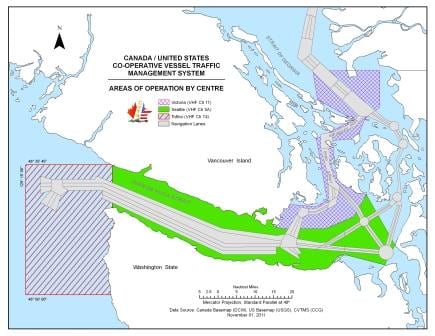By 08.00 in the morning, the ship lined up for entering Strait Juan de Fuca. Because it is such a busy waterway the strait has been divided into an ingoing route and an outgoing route. It is called a Vessel Traffic Separation Scheme. (VTSS) The peculiar thing with Juan de Fuca is, is that the VTSS scheme straddles two countries. The outbound lane is in Canadian Waters and the Inbound Lane is in American Waters.
To make sure that everybody is behaving themselves there is also a Traffic Control system. Again also divided between the two countries. The approach to the entrance is handled by the Canadians. It is called Tofino Traffic and named after the town where the Control station is located. All inbound and outbound traffic has to call in here to get cleared and to receive last minute information if needed. They already know if a ship is coming as a pre-clearance message has to be sent a certain number of hours before entering the area covered by the system.
The message results normally in a pre-clearance when you are inbound. If the message is not received, there would be the option that you have to wait until clearance is given. Once Tofino has approved your coming into the Strait, you can sail in and when about half way, you are handed over to Seattle Traffic which monitors the traffic further in the Strait and the traffic going to the Pudget Sound area. At various locations you have to call in with a position report (To verify what they see on their Radars) and receive the latest traffic update.

Strait Juan de Fuca with the VTSS in the middle. The grey lanes indicate the routes all the ships are required to follow. There are even round-a-abouts in it to make it safer when crossing lanes. (Diagram, courtesy USCG)
Once through the Strait you stay with Seattle Traffic if you continue into American Waters or you are handed over to Victoria Traffic if you are turning north towards Victoria or Vancouver. If you forget to call in, there will be quite quickly a berating voice on the VHF to ensure that you do not forget it a second time. Although English speaking on the ships has greatly improved in the last 20 years we still have occasionally ships that exhibit a very peculiar way of communicating and a very particular way of using the English Language.
I have heard conversations where one ship or the other was convinced that Seattle Traffic was a sort of messenger service with the result that an officer started reciting a complete shopping list to be forwarded to the ships agent. At another time a ship got really upset because it could not order a pilot via the VTS system. Normally the VTS is willing to help out with passing on ETA’s but it is not a booking service. They will raise the pilot station for you if you cannot get through. The dispatchers at the pilot stations are normally listening in anyway but their VHF antennas’ normally do not have the reach or the prominent locations of the VTS stations so direct communication can sometimes be challenging.
But the real duty of a VTS station is to ensure a safe flow of the traffic. Everywhere in the world we now have these vessel separation schemes, born out of necessity as there were too many accidents or close calls. They do not do anything directly apart from VHF contact but as they can inform ships of what is developing the result is that 99% of the time everything goes safely, day in day out. The remaining 1% is what cannot be controlled as there is no system which is completely fail safe. But VTS has of course the option to alert the Coastguard or any other law enforcement or support organization which has the capability of taking action. Either by dispatching patrol vessels or air craft or being on the dock when a ship arrives and investigate the issues which were reported by the VTS system.
The Statendam nicely called in at all the calling points and was allowed to progress accordingly. The Bridge gave their notice to the pilots for their boarding time and at the agreed time of 11.30 the Canadian pilot for Victoria hopped on board. We were the only cruise ship in today and by 12.30 the first guests proceeded ashore to start supporting the local economy.
The weather turned out as predicted. A chance of showers, one big one shortly after arrival and then it was dry for the remainder of the day.
This evening we will sail at 11 pm. for a quick hop across the Pudget sound to end our cruise in Seattle tomorrow morning.

July 30, 2015 at 7:48 pm
It could very well have been the same big downpour we had in the downtown Vancouver harbour when the Zaandam arrived. Brolli time. The rain didn’t dampen the jolly time of an arriving ship getting waves, salutes and shouts from the crew, and giving a variety of welcoming waves.